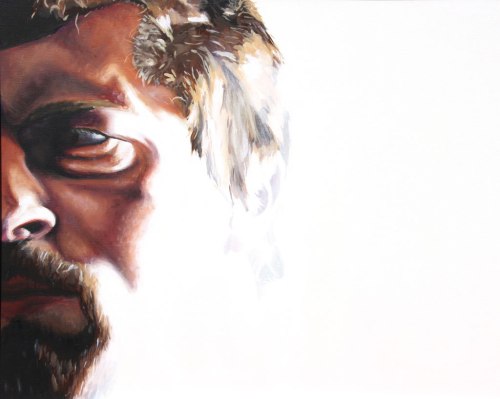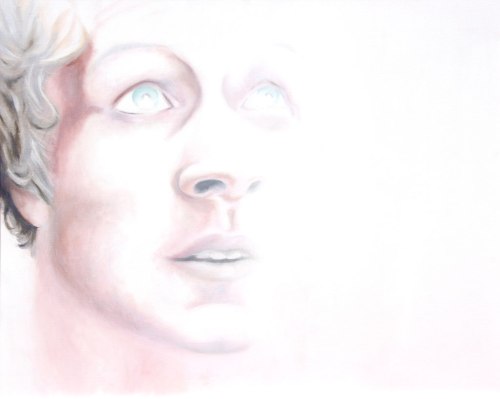Archetypes was my first true series.
This particular series started as just one painting. When I first arrived at Fontbonne University for graduate school I saw many students working the same style of painting. They were focusing on the figure with a Caravaggio-esque tenebrism. For those of you who are not artists, tenebrism is when an object or figure comes out of the shadows with a strong highlight against a murky background.
I wanted to do something different than what I was seeing in the studios. I wasn’t bold enough to be like James Ensor and paint everyone pink (which he got kicked out of university for), so I tried to flip tenebrism on its head. I painted a portrait with a figure coming out of the light with a white background.

John 19:26
I used my wife as the model. It didn’t mean anything more than a portrait study. I spent about a week in my studio thinking about what I wanted to paint next. I looked at this image of my wife for hours. I thought she looked sad, but resolute. It occurred to me that she looked to me like the way Mary, the mother of Jesus, would feel when she saw her son crucified. In art, the colors blue and purple represent Mary, which fit her blue eyes and her purple, tanzanite earring. The earring is even trillion cut, which makes it a perfect symbol for the trinity, which became unified through Mary. So, the painting became Mary.
Most of the time, my paintings start with an idea, but this time the ideas came after the painting. I decided that the white light should symbolize Christ. I made the highlight in her iris into a cross to show that she is observing the death of her son.
My mother lost her firstborn son when he was 11 years old. We never talked about it much growing up, but I’ve seen the way she looks when she does mention him. It’s a combination of grief and comfort. Grief for losing a child, and comfort for knowing that he has gone to be something greater. That is what I want to show in Mary, a grieving mother finding strength and despair simultaneously in Christ.
That was the jumping off point for the series. I started with Mary, and went right on to Judas.

Luke 22:22
I began thinking about different people who came in contact with Jesus. He was only one man, but the Bible records many differing reactions to him and to his ministry. I decided to make a series showcasing those different reactions, and comparing them to the reactions that people have upon exposure to Christianity and faith today. I preserved light as a symbol for Christ, using the reaction to light to show a reaction to Christ. I focused on the eyes, because light enters through the eyes. Judas was very affected by Christ, but rejected him and did not let him in. No one could be that close to such an influential person without being drawn in unless they purposefully look away. Judas was greedy and self-serving. Sometimes the acceptance of a new idea requires the rejection of oneself. Judas could not reject his own self, so he rejected Christ instead. I wanted to show how people who are so afraid of outside influence or control will look away to avoid change, even if the change is good.
I used myself as a model for Judas. First of all, I couldn’t bring myself to ask someone to pose as Judas, who committed the ultimate evil according to Dante, who put him in the lowest ring of hell. Secondly, I didn’t have time to go and find a model because I had already wasted a week thinking about and planning what to paint.
I stayed up all night, and photographed myself in the morning. My hair was messed up, my eyes were puffy, and I looked drawn out. I wanted it to show how an intense psychological struggle, such as Judas experienced, causes visible physical damage. Trying too hard to preserve yourself will destroy you from the inside. I painted his lips a strong red to symbolize the kiss that was his act of betrayal. A kiss is an act of love, but his was one of hatred, jealousy, and was his tipping point into guilt, despair, and eventually suicide.
The third painting in the series is John.

Revelation 1:12
Once again, I used myself as the model. I had to invent my chin and lip, since I always have facial hair. I am willing to stay up all night, or spend countless hours in study, but I won’t shave off my beard. Even my wife of over 6 years has only seen my chin two or three times.
This is the most high key of the paintings. John was extremely spiritual. As the writer of Revelation, he was so focused on Christ that he lost much of his clarity. He let the light of Christ completely overcome his life to the point of losing his grip on the physical. I wanted to show that he was so immersed in his faith, that he is lost in it. He was so centered on the next life that he ceased to be a part of this life.
John takes his faith to the breaking point of obsession. It is almost too much. Sometimes when someone’s outlook changes, they are so passionate about their new beliefs that it engulfs their entire life.
I tend to get stuck on one subject at a time. One summer I decided I wanted to understand quantum physics. I spent the entire summer studying. I’m sure I drove my wife crazy talking about particles and dimensions. I was always a little bit distracted. This is how I view John. He was so wrapped up in his faith that he was a little bit removed from everything else.

You studied at Fontbonne? No wonder you’re so good! Did you study with Tim Liddy?
LikeLiked by 2 people
Yeah, I studied with Tim. He’s a great guy!
Your profile says you’re from St. Louis, how wonderful! My wife and I just bought a house in Old North.
LikeLike
That was interesting…did you just write this or did not see it before?
LikeLike
Yes, I just wrote it.
LikeLike
We’re in U. City. 🙂 There are some seriously talented artists here in St. Louis-wish people knew this!
LikeLike